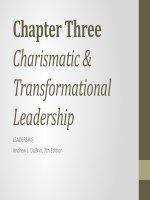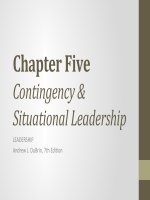Chapter 15 leadership research findings practice and skills 7th edition
Bạn đang xem bản rút gọn của tài liệu. Xem và tải ngay bản đầy đủ của tài liệu tại đây (567.74 KB, 12 trang )
Chapter Fifteen
Leadership Development
& Succession
LEADERSHIP
Andrew J. DuBrin, 7th Edition
Learning Objectives
• Explain how leaders develop through self-awareness and selfdiscipline.
• Explain how leaders develop through education, experience,
and mentoring.
• Summarize the nature of leadership development programs.
• Describe the nature of leadership succession.
Leadership Development
• Unless top-level management assigns a high priority to
developing leaders and succession planning, the
company will experience a steady attrition in talent.
• Leadership talent can be developed – remember that
leaders are both born AND made.
• Leadership development is often perceived in terms of
education and training, job experience, and coaching.
Leadership Development Through
Self-Awareness & Self-Discipline
• Self-Awareness – Insightfully processing
feedback about oneself to improve one’s
effectiveness.
• Self-Discipline – Mobilizing one’s effort
and energy to stay focused on attaining an
important goal.
Development Through Education,
Experience, & Mentoring
• Education
• Experience
• Challenging Experiences
• Broad Experiences
• Pivotal Life Experiences
• Mentoring
• Formal
• Informal
• Shadowing
Leadership Development
Programs
• Feedback-Intensive Programs
• Skill-Based Programs
• Conceptual Knowledge and Awareness
Programs
• Personal Growth Programs
• Socialization Programs
• Action Learning Programs
• Coaching and Psychotherapy
Leadership Succession
• Orderly process of identifying and grooming
people to replace managers.
• Succession planning is linked to leadership
development in two ways:
• Being groomed as a successor is part of
leadership development
• Process of choosing and fostering a successor
is part of a manager’s own development
Emotional Aspects of
Leadership Succession
• Should not be regarded as a detached, objective
management process.
• In family firms, leadership succession is a highly emotional
process.
• Turnover and productivity can be impacted
• Emotional reactions can occur throughout the organization
Developing a Pool of
Successors
• Evaluate the extent of an organization’s pending leadership
shortage
• Identify needed executive competencies
• Identify high-potential individuals for possible inclusion in
the pool
• Establish an individually tailored developmental program for
each potential candidate
• Select and place people into senior jobs based on their
performance, experience, and potential
• Continuously monitor the program and give it top
management support
Growing Inside-Outside
Leaders
• Should a company promote an insider or an
outsider to a top position?
• Insiders know the company, culture, and people
within the firm.
• Promoting insiders demonstrates opportunities for
advancement to other workers.
• Political ties and unclear thinking can hinder an
insider’s potential.
• Best solution is to groom insiders with an outsider
perspective.
Challenges of Being a New
Leader
• Time Management
• Overcoming Resentment
• Building Relationships Quickly Enough
• Being Realistic About the Process
• Becoming Comfortable with Unpopularity
Summary
• Leadership and management development are widely practiced in many
firms.
• Leadership development may include self-development or an
organizationally-supported leadership development program.
• Education, leadership experience, and mentoring are all contributors to
leadership development.
• Organizationally-supported leadership development programs vary widely.
• Leadership succession is linked to leadership development.
• Succession can have emotional outcomes.
• Research shows insiders with outside perspective make good leadership
candidates.
• First-time leaders must face inevitable challenges in their role.









